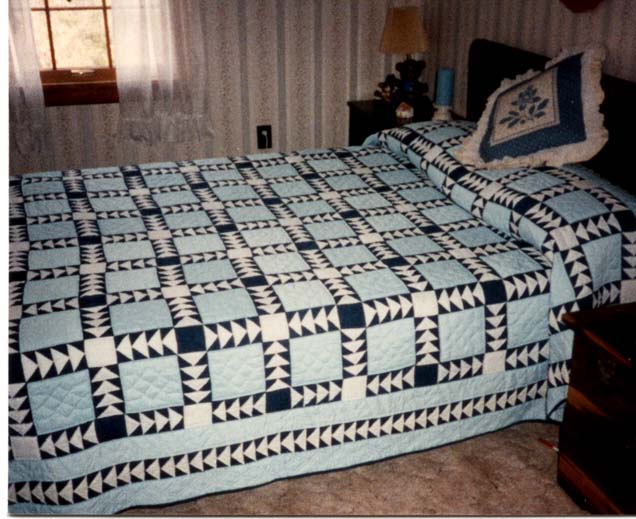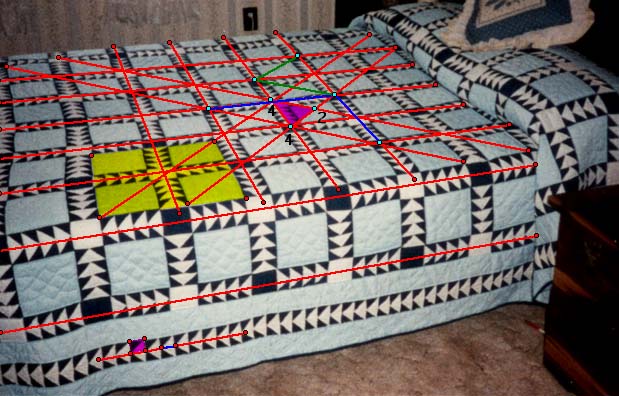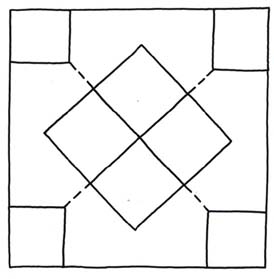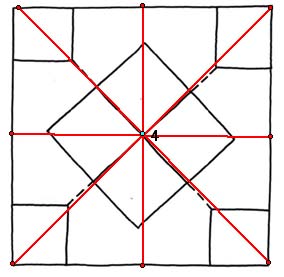Flying Geese
*442

Analysis of Flying Geese

KEY:
1) red segments represent reflection mirrors
2) light green segments represent glide mirrors
that are not reflection mirrors
3) dark blue segments represent translation generators
4) dark green segments represent shortest glide vectors
that are not translation generators
5) yellow points represent cyclic centers
6) light blue points represent dihedral centers
7) fundamental region is shaded pink
8) quilt block is shaded yellow
Symmetries present: reflection,
glide reflection, rotation, translation
Description of symmetries: There
are vertical, horizontal, and diagonal reflection mirrors
(i.e. at 45 degree angles) as shown. These mirrors are also glide mirrors.
4-fold dihedral rotation centers
are located at the intersection of 4 mirror lines; 2-fold dihedral rotation
centers are located at the
intersection of 2 mirror lines. The translation generators we chose are twice
the distance between the
horizontal and vertical mirrors. The shortest glide vectors are the same length
and direction as the shortest translation
vectors (the shortest diagonal glide vectors are marked because they are not
either of the two translation generators we chose.)
Description of fundamental region:
an isosceles right triangle that has mirrors
for sides (smallest one that can have mirrors for sides.) Note that the 4-fold
centers are located at the 45 degree angle vertices, while the 2-fold center
is located at the right angle.
Description of symmetries in block:Blocks
also have a 4-fold dihedral center, located at the center of the block. Note
that the block is identifiable because of the "geese" (white isosceles
triangles) flying toward the "pond" (white square.)
Relationship between block and fundamental region:A
block is approximately 16 fundamental regions;
the relationship is only approximate because of the "border" strips
used to piece together the blocks. That is, the chosen fundamental region
includes a portion of these strips, but the block does not.
Analysis of stitching within a block: The
stitching within the light blue parts of the block is shown below. Note that
there is a 4-fold dihedral center in the middle of each of the light blue
squares, but that in the quilt, the center in the middle of these squares
is 2-fold. This is because of the strips used to piece together these light
blue squares--i.e. there are no vertical and horizontal mirrors through the
middle of the light blue squares in the actual quilt.


Flying Geese Border Patterns
To see entire quilt, scroll up to the top.
THG, or i*

Analysis of quilt border (made from pieces)
The center line is a horizontal mirror (and
therefore also a glide mirror.) The shortest translation vector of the strip
pattern is equal to the height of the isosceles triangle drawn to the base
of triangle. This vector is also the shortest glide vector. The fundamental
region is a square (includes half of the white isosceles triangle.)
TRVHG, or *22i

Note that this stitching occurs in the light blue region
below the pieced pattern above.

Analysis of quilt border (made from stitching)
There are vertical mirrors and the center line
is a horizontal mirror (and therefore a glide mirror.) The shortest translation
vector of the strip pattern is equal to the longer diagonal of the rhombus
figures. This vector is also a glide vector. There are 2-fold dihedral centers
at the intersection of the mirrors. The shortest translation vector is equal
in length to twice the distance between the vertical mirrors. This vector
is also the shortest glide vector. The fundamental region is a rectangle that
has mirrors on three sides (includes basically one-fourth of the rhombus figure.)






